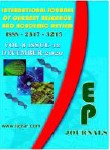Abstract Volume:8 Issue-12 Year-2020 Original Research Articles
 |
Online ISSN : 2347 - 3215 Issues : 12 per year Publisher : Excellent Publishers Email : editorijcret@gmail.com |
PD is the second most NDD and its main pathological hallmark is the loss of dopamine-producing neurons that leads increased nigral iron content as well as the presence of aggregates of misfolded proteins. Brain iron homeostasis is relying on IRP and Fe-S cluster proteins that bind to IREs. Iron cross the BBB through the classic TfR-mediated endocytosis and excess iron in neurons and neuroglia can be exported back to the brain interstitial fluid, and can be released into the CSF in the brain ventricles then transport back to the blood circulation. Excessive iron deposition in the brain may cause a cascade event of oxidative stress and neuroinflammation. Increased nigral iron content in patients with PDs is a prominent pathophysiological feature involved in selective dopaminergic neurodegeneration. Early life iron exposure has been proposed as a possible risk factor for PD, and has been shown to stimulate midbrain neurodegeneration with age. CP is a MCO, the major plasma anti-oxidant. GPI secreted in CSF with ferroxidase activity to play a vital role in iron metabolism, which can be considered as the genuine link between Cu and Fe metabolism. Significant loss of ceruloplasmin-ferroxidase activity has been observed in CSF and substantia nigra of PD patients and leads to cellular iron retention. Oxidative modification in Cp leads to Cu release and increases in the CSF which facilitates Fenton’s reaction then amplifies general protein damage in PD.
How to cite this article:
Yiglet Mebrat. 2020. Early Life Iron Exposure and CSF Levels of Cu/ceruloplasmin Correlated with Parkinson’s Disease.Int.J.Curr.Res.Aca.Rev. 8(12): 96-108doi: https://doi.org/10.20546/ijcrar.2020.812.009



Quick Navigation
- Print Article
- Full Text PDF
- How to Cite this Article
- on Google
- on Google Scholor
- Citation Alert By Google Scholar
